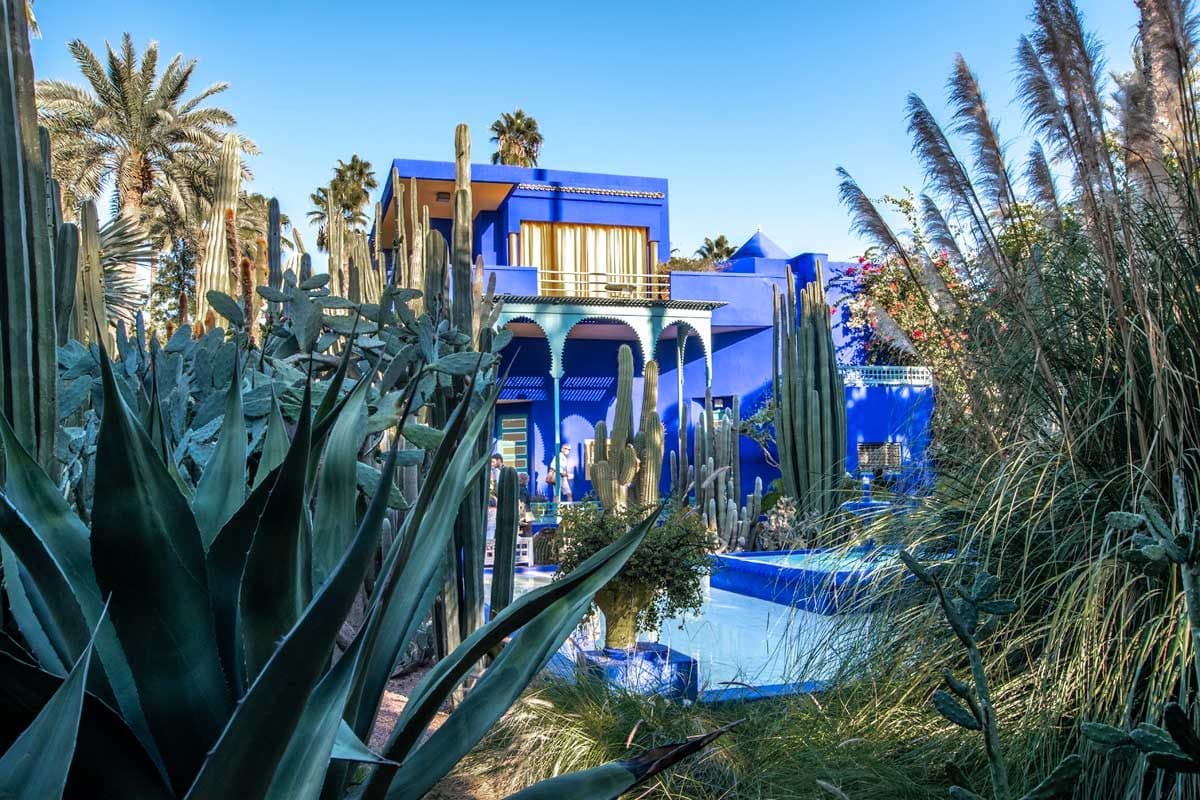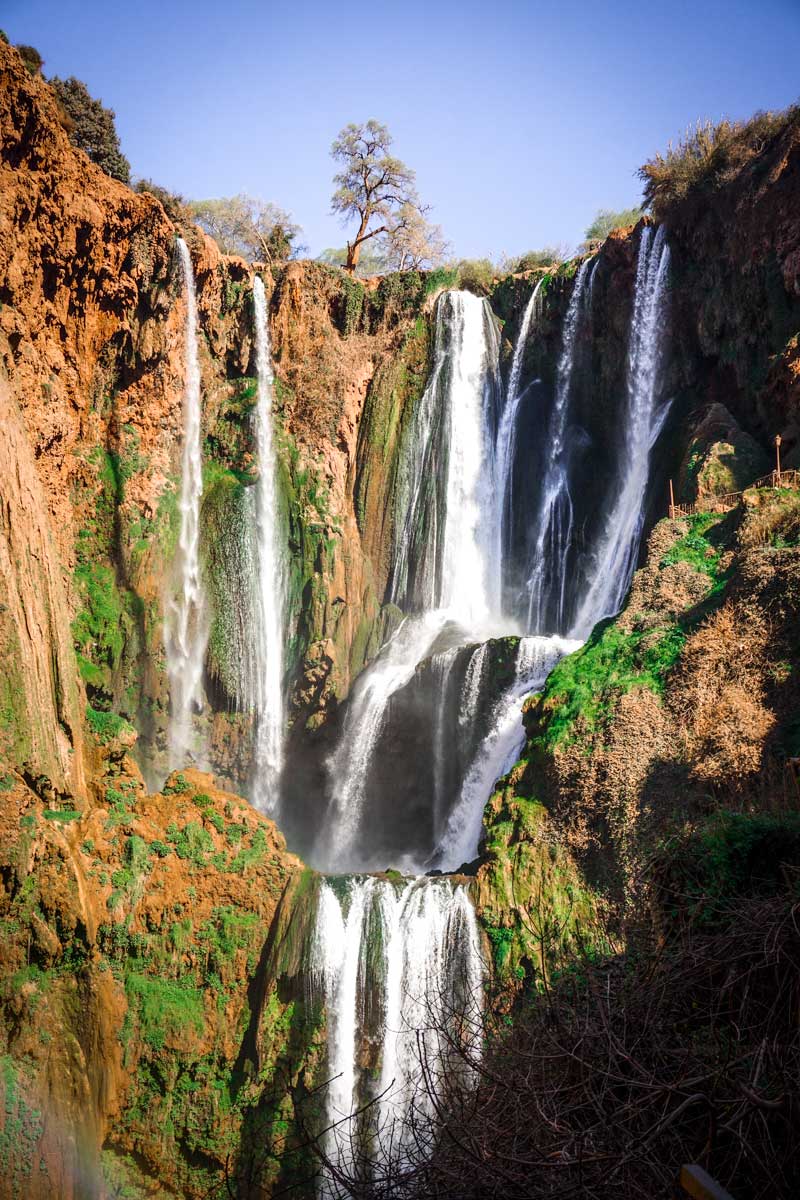Discovering the top landmarks in Morocco was an adventure of a lifetime. The North-African country is an incredible trove of exotic culture, breath-taking nature, and authentic sights, hard to find anywhere else on the globe. Morocco has no nickname, so I named it the ‘Land of Colors’. Why? Because Morocco’s all about colors! The mosaics, the spices, the markets, the homes, even the people, everything there is just bursting with color. Even their most famous cities have a trademarked color.
I’m telling you this to prepare you for a list, more colorful and exotic than a parrot with a sombrero (yes, they exist, but that’s a different story).
From the mystical red city of Marrakech to the legendary Sahara desert, here are the top Morocco landmarks.
Hasan II Mosque, Casablanca

We start our list with a marvel of human architecture. Mosques in Morocco are forbidden for non-muslims. All mosques but one. The awe-inspiring Hasan II Mosque is created with the primary purpose of showing the greatness of Morocco and its people.
Built by more than 10,000 craftsmen, the mosque features the tallest minaret in the world (210m), the finest materials from across Morocco – marble from Agadir and cedarwood from the Middle Atlas Mountains, and a beautiful blend of traditional Moorish architecture and 20th-century equipment.
Even though it’s only the 8th-biggest mosque in the world, the temple can accommodate 105,000 people – 25,000 inside and 80,000 in the courtyard.
Castaway Fact
The Hasan II Mosque is set on an outcrop extending over the ocean following verse of the Qur’an, asserting that ‘the throne of Allah was built on water’.
Djemma el-Fna Square, Marrakech

Inscribed in UNESCO’s Representative List of the Intangible Cultural Heritage of Humanity, the Djemma el-Fna Square is the heart of mystical Marrakech. Dating back to more than a thousand years, the square is a gathering place of storytellers, fortune-tellers, street performers, teeth collectors (yeah!), and of course, thousands of tourists.
During the day, the square is relatively quiet. There are some snake-charmers and juice vendors, but that’s nothing compared to what happens after dark. Once the sun goes down, Djemma el-Fna comes to life. Restaurant stalls open all around the plaza. Street dancers, acrobats, henna artists, and all sorts of entertainers suddenly appear and begin their performance.
Being on the square may be a little overwhelming, so I suggest observing the transformation from one of the cafes overlooking Djemma el-Fna. Get a traditional mint tea, and enjoy the greatest shows in Marrakech!
Psst! See everything Marrakech is famous for!
Majorelle Garden, Marrakech

I’ll be honest with you – the Majorelle Gardens are not among my favorite Morocco landmarks. While I do see the appeal of the bright blue designer-building and its gardens, this attraction has become so popular that there’s no way to avoid the tourist crowds.
For me, the key feature of a park or a garden is its serenity, the opportunity to reconnect with nature and forget about the bustling city around you. The tiny Jardin Majorelle is way too busy to let you do that.
Anyway, being the former home of the world-renounced designed Yve Sait Laurant, this small mansion features an impressive botanical collection and a mini Islamic Art Museum. Designed by the landscape painter Jacques Majorelle, the gardens are considered to be the best in Marrakech and continue to be its most prominent landmark.
See Also: What to Skip in Marrakech
Bahia Palace, Marrakech

In Arabic, Bahia means brilliance, and there’s no better way to describe this stunning construction. Probably the most well-preserved historical site in Marrakech, the Bahia Palace offers a glimpse of 19th century Marrakech.
Initially built for the grand vizier – Si Moussa, the place features more than 150 rooms (including a harem) and lush private gardens. Decorated with elaborately carved stuccos and cedarwood, this eye-popping construction is undoubtedly one of the must-see landmarks in Morocco.
Sahara Desert

In my travels, I’ve visited plenty of extraterrestrial places so you can trust me when I say – nothing can prepare you for the majesty of the Sahara desert. There’s one moment, in particular, I’ll remember for the rest of my life – riding a camel before sunrise. Nothing around me but stillness, velvet-soft dunes, and billions of stars. The most magical experience imaginable.
The golden dunes of Sahara, made famous by Holywood a long time ago, are a sight I urge everyone to see in person. No matter who you are, the overwhelming natural beauty of this legendary desert is sure to leave a mark on you forever.
Chefchaouen Medina

It’s time for one of the most outlandish landmarks in Morocco – the Blue Town of Chefchaouen. You’ve probably seen pictures of it on Instagram, and you may be a little skeptical. I mean, pictures often don’t show the true reality of a place, especially the ones on IG. Chefchaouen, however, is the real deal!
The whole medina (old part of town) is painted in a baby-blue color. Houses, streets, doors, cats, everything there is bright blue! Okay, maybe not the cats, but everything else is. Even people wear mostly blue clothes there.
Chefchaouen is an incredibly unique and peculiar Morocco landmark that makes for a great conversation-starter back home and is a definite must-see.
Castaway Fact
Chefchaouen medina is blue because its first inhabitants were Jewish. For them, the blue symbolizes the sky and reminds them of God.
Blue Gate, Fes

The Blue Gate or Bab Bou Jeloud, as it’s known locally, is among the most significant symbols of Fes. Being one of the grand gates to the fantastic Fes medina, Bab Bou Jeloud is colored in blue to represent the city’s signature color. Fes is the former capital of Morocco and one of the most authentic towns you can find in the Kingdom. The most prominent productions of Fes are leather goods and cobalt-blue pottery.
Castaway Fact
On the inside, the Blue Gate is actually green – the color of Islam.
Chouara Tannery, Fes

The Chouara Tannery is the biggest attraction in Fes and one of the most famous landmarks in Morocco. It’s the largest of the city’s several tanneries and operates since the 16th century. Not only that, but the tannery workers also use the same leather-dying methods as their forefathers.
The combination of hard manual labor, colorful dye jars and horrible reek, act as a time machine (way better than the jacuzzi one) that transfers you straight to medieval Morocco. A must-see landmark, you should definitely check if you’re in the area. Just make sure you’re prepared with a mint stalk to hold under your nose.
See Also: The Ultimate Morocco Travel Itinerary
Al Attarine Madrasa, Fes

Standing in front of the Fes’ spice and perfume souk, Al Attarine is the most beautiful madrasa in the country (at least until Marrakech’s Ben Youssef Madrasa reopens).
But what’s a madrasa?
Madrasas were the centers of religious teachings in the past. They feature exquisitely ornamented designs and are popular tourist attractions in Morocco. Al Attarine Madrasa was built between 1323 and 1325 by the Marandi sultan Abu Sa’id Uthman II. He’s one of Morocco’s most renowned sultans known to hate war and be an art and craftmanship patron.
Psst! Check out a few more fun Morocco facts!
Castaway Fact
Al Attarine Madrasa translates to “the madrasa of perfumes”. It’s named after its location right in front of the perfume souk. It’s unbelievable that this market is still in the same place where it was 700 years ago!
Ait Ben Haddou

All Morocco landmarks listed here are impressive sights, but there’s nothing more impressive than the fantasy desert castle known as Ait Ben Haddou.
A UNESCO World Heritage Site since 1987, the kasbah used to be a major stop along the caravan route between Marrakech and Sahara. It’s made out of red clay brigs, and it’s an excellent representation of 17th century South Moroccan architecture.
The fairy look of Ait Ben Haddou hasn’t been unnoticed by Holywood. The kasbah was featured in many famous movies and series, including Russell Crowe’s ‘Gladiator’ and ‘Game of Thrones’.
Castaway Fact
While the crumbling clay walls of Ait Ben Haddou are hardly fit for modern life, five families still call the fortress their home.
Todra Gorge

Todra Gorge is the epitome of Morocco’s natural landmarks. Situated on the east side of the High Atlas Mountains, this spectacular canyon is not the easiest to get to. Still, its appeal is so overwhelming that it managed to become a famous tourist attraction. The nearby Berber town of Tinerhir is home to 35,000 people, but in the top tourist months, the population grows to 90,000! Not bad for a landmark situated in the middle of nothing.
See Also: Winter in Morocco – All You Need to Know
Medina of Essaouira

The Essaouira medina was once known as Mogador (not to be mistaken with Mordor), and it’s one of Morocco’s most mesmerizing UNESCO World Heritage sites. Located on the Moroccan coast, approximately 350km south of Casablanca, Essaouira was once a sleepy fishing village but eventually grew into the significant seaport town that is today. Thanks to Mogador Island that protects the harbor from high seas and strong winds, Essaouira is the best place to enjoy a beach vacation in Morocco.
Ouzoud Falls

Cascades d’Ouzoud is the most famous waterfall in Morocco. A popular Marrakech day-trip, the Ozoud Falls offer a stunning site with a 110 meters-high, vigor waterfall – something incredibly rare for the hot and dry North Africa region. Surrounded by charming Berber villages, the falls are also home to a significant population of macaque monkeys.
The monkeys are used to tourists, so be very careful when interacting with them. Make sure your phone and sunglasses are safe, and there are no loose items on you. The macaques are known to be skillful thieves. The Ouzoud Falls are one of the most prominent landmarks in the Atlas Mountains and a wonderful getaway from chaotic Marrakech.
See Also: Top 20 Landmarks in Greece
The High Atlas Mountains

Before going to Morocco, I expected a desert landscape with velvet dunes everywhere. Imagine my surprise when I found out that the country’s desert area is relatively small, and the dominant landscape is the mountain one. It’s not surprising that one of the biggest landmarks in Morocco is a mountain range – the High Atlas Mountains.
The North Afrika’s highest chain is called Idraren Draren by the Berbers, meaning Mountain of Mountains. It acts as a weather barrier separating the scorching heat of Sahara from the mild Mediterranian north.
The villages and sceneries around the Atlas Mountains are considered by many to be the real Morocco and offer incredible experiences to the trekkers who dare to explore them.
Volubilis

The ruined Roman city of Volubilis is Morocco’s best-preserved archeological site and a UNESCO World Heritage Site since 1997.
The former Mauritanian capital was founded more than 2,000 years ago and used to be an important Roman trading post. It’s believed that in its prime, the wealthy city was home to more than 20,000 people. Some of their lavished homes still exist today and reveal with great detail what life used to be in one of the most remote cities of the Roman Empire.
That’s all from me, I hope you enjoyed these15 landmarks in Morocco.
————————————
If you haven’t planned your trip there yet, find out how I plan my trips!
————————————
I have 14 bucket list ideas for Morocco. See my impossible bucket list of 1700+ adventures!
Which one is your favorite?
Some of the above are affiliate links and I will earn a percentage of the sale if you purchase through them at no extra cost to you. This helps keep my site running – so thanks in advance for your support!




